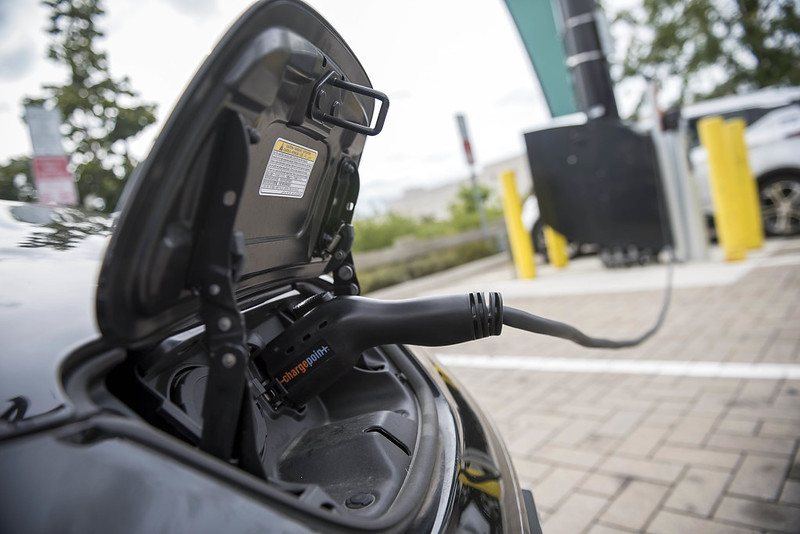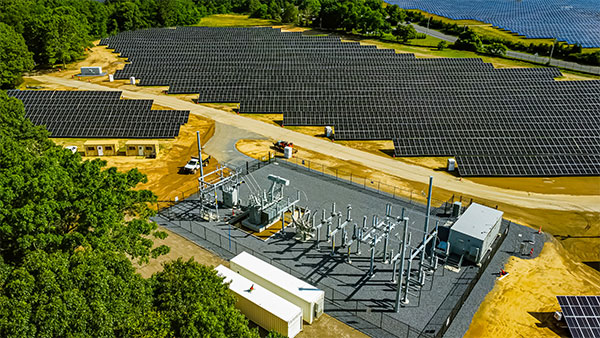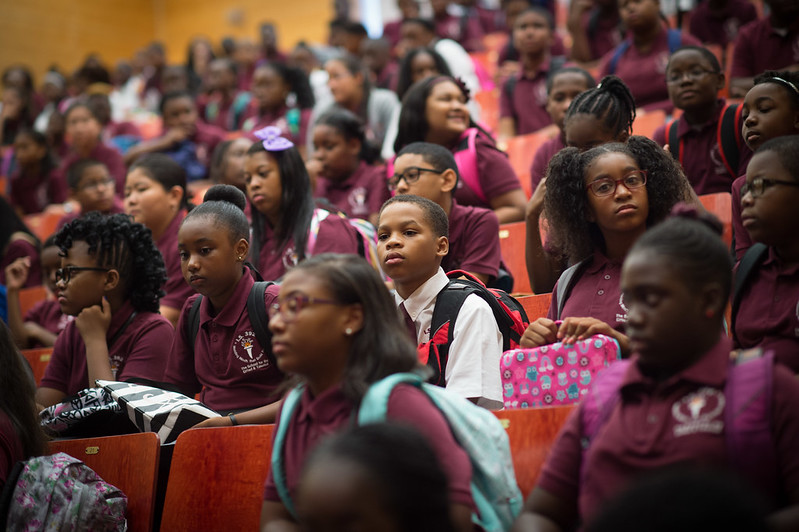Recharge NYC Climate Policies; City Government Must Finally Transition to Zero-Emission Vehicles

Electric vehicle charging (photo: Ed Reed/Mayoral Photography Office)
It’s Climate Week but you don’t need to be an environmental expert to see the devastation and daily effect that fossil-fuel driven climate change has on our communities.
Whether it’s the oppressive heat waves rolling over our cities, families being washed away by deadly flash floods, or any of the other extreme weather events we have to contend with now as part of our day-to-day lives, the immediate and irreparable impact of the quickening pace of climate change is all around us.
This scary scenario begs the question, what are we doing about it? Unfortunately, the answer is not nearly enough and not fast enough. Aside from failing to achieve a decrease in carbon emissions, we are nowhere close to reaching steady-state emissions goals and clearly losing the battle to even stop annual increases in carbon dioxide (CO2) emissions with the CO2 global average reaching another record high in 2021 at 415 parts per million (ppm).
Last year New York City committed to having a fleet of zero-emission vehicles by 2035. This effort would help the City actually reach its climate goals, reduce toxic air pollution that disproportionately harms communities of color where child asthma rates are well above the citywide average, and, as an added bonus, strengthen the city’s economy with new construction and renewable energy infrastructure jobs.
But this “commitment” alone isn’t enough. New City Council legislation – “Zero Emission Vehicles for NYC” – would greatly accelerate the city’s adoption of zero-emission vehicles. Instead of city agencies continuing to buy or lease traditional internal combustion engine (ICE) vehicles for years to come, we can fast-track the purchase of zero-emission vehicles that will allow us to finally set a course towards meaningful climate goals.
In 2019, New York City passed the Climate Mobilization Act, the most ambitious legislation in the country to reduce building emissions. Emissions from stationary sources, which are mostly buildings, accounted for 70% of New York City’s emissions in 2020. The second biggest source of emissions is transportation: 25% of emissions. New York City’s lack of progress in addressing transportation emissions is deeply troubling. It has the largest municipal fleet in the country, approximately 30,000 vehicles, yet it has purchased or leased fewer than 750 light-duty battery electric vehicles (BEVs) and has not deployed significant numbers of medium-duty or heavy-duty BEVs. However, zero-emission choices exist in all relevant vehicle types, including general purpose vehicles, ambulances, fire trucks, pursuit-rated police vehicles, sanitation trucks, school buses, and street sweepers.
The new bill would require New York City to purchase or lease only zero-emission light-duty and medium-duty vehicles beginning July 1, 2025; and heavy-duty and specialized motor vehicles beginning July 1, 2030; and require the city’s entire fleet be converted to zero-emission vehicles by July 1, 2035.
Transitioning the New York City government fleet to zero-emission vehicles is a critical step towards safeguarding the health of New Yorkers, especially those who live in environmental justice communities that have historically borne the brunt of environmental racism, including disproportionate pollution burden. For example, Bronx residents are besieged by the air around them, particulate matter levels two-and-a-half times higher than the state average, and in the South Bronx, children and teenagers visit emergency rooms with asthma-related illness at rates twice the city average, and nearly 20 times the frequency of neighborhoods with the lowest rates. Tackling emissions by reshaping the city fleet is a critical first step towards fixing this injustice.
States and cities that take real action will experience the most job creation as the world transitions from oil to electricity. New York businesses and consumers spend over $20 billion each year on gasoline and diesel fuel produced in other states and countries. As electricity is substituted for oil, this money will increasingly stay in-state, creating livable wage jobs in renewable energy production, both at utilities and in construction. The bill will accelerate this state-wide trend and also strengthen the prospects of New York City-based mobility and energy infrastructure firms such as Charge Enterprises, Gravity, Ideanomics, NineDot Energy, REV Renewables, Revel Transit, Tarform Motorcycles, and others.
While many city government leaders have expressed support for emissions reduction policies, good intentions alone do not result in meaningful action. It is clear we need to speed up our clean energy efforts if we are serious about addressing the climate catastrophe facing us.
This new bill will do just that, expediting progress while also offering smart flexibility in making the transition to zero-emission vehicles achievable. Communities on the frontlines of climate change and at the epicenter of the devastating impacts of the fossil fuel economy simply cannot afford any more delays and inadequate measures.
***
Wayne Arden is Sierra Club NYC Transportation Chair. Arif Ullah is Executive Director of South Bronx Unite. On Twitter @scnycgroup & @SouthBronxUnite.
***
Have an op-ed idea or submission for Gotham Gazette? Email This email address is being protected from spambots. You need JavaScript enabled to view it.
Long Island is Becoming a Clean Energy Hub to Replicate Across the Northeast and Beyond

The Calverton Solar Energy Center, Riverhead, NY (photo: National Grid)
This week, thousands of leaders are in New York for Climate Week 2022. While the presentations and networking are happening in New York City, the action is taking place to the east on Long Island.
As more clean energy solutions like offshore wind, solar, battery storage, and clean hydrogen surface, Long Island is quickly emerging as a clean energy hub. Applying the solutions that are working here to other communities throughout the Northeast will be critical to mitigating climate change while continuing to provide reliable, affordable energy to residents that call this region home.
The key to Long Island’s success as a clean energy hub is a hybrid approach to decarbonization that incorporates multiple sources of renewable electricity and heat.
In Riverhead, the 23-megawatt Calverton Solar Energy Center powers more than 4,200 homes. This reduces carbon emissions 20,000 metric tons per year – equivalent to removing 4,000 cars from the road. In addition, the waters surrounding the island will soon be home to offshore wind projects including the South Fork Wind Farm and Community Offshore Wind, a joint venture between National Grid and RWE that has the potential to host 3 gigawatts of capacity – enough to power more than one million homes. To ensure consistent power supply, regardless of the weather, National Grid and NextEra Energy Resources have built 80 megawatt-hours of battery storage in Montauk and East Hampton, which is crucial for ensuring reliable service when it is not windy or sunny.
Alongside these traditional sources of renewable energy, Long Island is also embracing cleaner fuels that can replace natural gas to provide clean heat. Renewable natural gas (RNG) and clean hydrogen can be used in the same way as natural gas, but are significantly better for the environment. Clean hydrogen is a nearly emissions-free alternative to fossil fuels produced by separating hydrogen out of the water molecule, leaving only water vapor behind.
Hempstead will soon be home to one of the first hydrogen blending projects in the nation, using existing wind and solar equipment to create clean hydrogen to provide heat. Existing power plants fueled by oil and gas on Long Island can also be replaced or converted to run on clean hydrogen instead of fossil fuels.
Together, these initiatives put Long Island on the path to becoming a clean energy hub that can serve as an example for communities in the Northeast and throughout the country. It helps that Long Island sits in New York state, which has one of the most ambitious clean energy agendas in the country and a goal that 70% of the state’s electricity will be fueled by renewables by 2030. However, a number of states in the Northeast are equally ambitious. Imagine the progress we could make on addressing climate change if the Long Island model became ubiquitous.
That is the long-term goal of National Grid’s new Northeast Clean Energy Vision. Building on the company’s recently-announced fossil-free plan, the Northeast Clean Energy Vision is a roadmap to establish the region as a leader in clean energy by developing a collection of large-scale hubs modeled after what is currently happening on Long Island.
Making this vision a reality across the Northeast will not be easy. Actions taken by New York state on infrastructure planning are critical to making meaningful, near-term progress. And the federal funding for projects that can mitigate climate change included in the Inflation Reduction Act is a huge boost, but we cannot stop there. We are now looking ahead to U.S. Senator Joe Manchin’s permitting bill that will ensure expedited siting approvals for clean energy projects. Additionally, we will need to strengthen our focus on putting communities first in the energy transition; one great example is workforce development programs.
The clean energy hub on Long Island is a great example of what is possible when industry and government work together to fight climate change. The technology choices are clear, but we need to continue to develop the right policies and the leadership to implement them.
***
Will Hazelip is President of National Grid Ventures, US Northeast. On Twitter @nationalgridus.
***
Have an op-ed idea or submission for Gotham Gazette? Email This email address is being protected from spambots. You need JavaScript enabled to view it.
Reimagine Alumni Support So It Works for All Students

Students at school (photo: Michael Appleton/Mayoral Photography Office)
I was a kid from Harlem, a first generation immigrant, and the first in my family to graduate from college – the U.S. education system was not built for kids like me to succeed.
Thankfully, along the way, I got the support I needed to excel and live out the dreams that my parents had for me as well as the aspirations I had for myself. Sadly, that is not the reality for countless kids from underserved communities just like me. But it can be, if we start to reimagine the support systems around them.
My parents left Ecuador with the hope that they could create a better future for their children, and they believed an American education was key to this. My father dreamed of having one of his children attend an Ivy League school. It felt out of reach, but all of that changed when my mom saw an advertisement for a new school in our neighborhood, and slowly but surely, their dream started to come true.
In 2005, my parents enrolled me as one of the first 100 students at KIPP Infinity Middle School in Harlem, a decision that changed my life. I stayed with the KIPP network of public charter schools through high school and then even more doors of opportunity were opened. During my time at KIPP, I traveled throughout New England to visit potential colleges, including Yale and Harvard, embarked on a 10-day excursion to Utah to hike Arches, Bryce, and Zion National Park, and visited China.
The world I knew expanded and I was influenced by these new environments. I got to experience new things, meet new people from all different backgrounds, and, perhaps most importantly, I got to work with a support system that knew how to prepare me to advocate for myself.
My advisors gave me the opportunity to identify my goals and the tools I needed to meet them. I learned how to prepare for college and succeed at the top schools. Before I knew it, I was opening my University of Pennsylvania acceptance letter in the mail on the auspicious date of 12/12/12.
But while I was learning and growing and taking advantage of every opportunity I could, other kids in my neighborhood were falling behind.
While I had college counselors helping me every step of the way – from applications to financial aid forms – most students do not.
KIPP Forward, the alumni support program that sticks with KIPP students once they graduate high school, helped guide me in college and helped me find a job post-graduation through peer and employer networking events, such as the KIPP Alumni Summit. For my friends who did not attend KIPP, any guidance many of my friends were receiving stopped the day they graduated high school.
The sad truth is: their experience is closer to the norm for students who look like me. For students of color, post-secondary preparedness programs are few and far between. In fact, Black and Latino students are inadequately enrolled in math courses and under-enrolled in Advanced Placement (AP) classes as compared to white peers.
These disparities continue through college, where students of color are significantly more likely than our white peers to drop out of post-secondary programming and education programs – creating a reality where white students at public colleges are 250% more likely to graduate than Black students, and 60% more likely to graduate than Latino students.
We can – and must, end these disparities.
My experience shouldn’t be the exception – it must become the norm. Our education system must develop postsecondary and career readiness programming, alumni support, and networking opportunities for all students so that low-income students of color across the country have the tools they need to chart their paths for success.
I keep in touch with my counselor to this day. In college, he visited me to help with my transition and helped me find the right internship opportunities. After graduation, I leaned on him for networking and guidance in my career. And now, I collaborate with him through our work at our alumni association.
At KIPP Forward, we are helping to change what alumni support can and should look like because the status quo has not been working for students of color. Our program is unique, but it is also scalable for schools across the country.
The support system we offer – which prepared me for college, helped get me to college, succeed in college, and supported my career after college – should be available for all students. If schools across New York and beyond do the same, we can reimagine what alumni support means, and finally provide all students with the keys to success.
***
Kevin Hidalgo is Senior Financial Analyst at American Express, and a KIPP NYC alumnus.
***
Have an op-ed idea or submission for Gotham Gazette? Email This email address is being protected from spambots. You need JavaScript enabled to view it.




